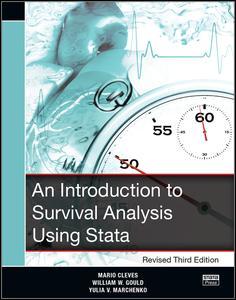Description
An Introduction to Survival Analysis Using Stata, Revised Third Edition (4th Ed.)
Authors: Cleves Mario, Gould William, Marchenko Yulia
Language: English
Subjects for An Introduction to Survival Analysis Using Stata...:
Approximative price 133.00 €
In Print (Delivery period: 15 days).
Add to cart· Paperback
Description
/li>Contents
/li>Biography
/li>
An Introduction to Survival Analysis Using Stata, Revised Third Edition is the ideal tutorial for professional data analysts who want to learn survival analysis for the first time or who are well versedin survival analysis but are not as dexterous in using Stata toanalyze survival data. This text also serves as a valuable reference to those readers who already have experience using Stata?s survival analysis routines.
The revised third edition has been updated for Stata 14, and it includes a new section on predictive margins and marginal effects, which demonstrates how to obtain and visualize marginal predictions and marginal effects using the margins and marginsplot commands after survival regression models.
Survival analysis is a field of its own that requires specialized data management and analysis procedures. To meet this requirement, Stata provides the st family of commands for organizing and summarizing survival data.
This book provides statistical theory, step-by-step procedures for analyzing survival data, an in-depth usage guide for Stata's most widely used st commands, and a collection of tips for using Stata to analyze survival data and to present the results. This book develops from first principles the statistical concepts unique to survival data and assumes only a knowledge of basic probability and statistics and a working knowledge of Stata.
The first three chapters of the text cover basic theoretical concepts: hazard functions, cumulative hazard functions, and their interpretations; survivor functions; hazard models; and a comparison of nonparametric, semiparametric, and parametric methodologies. Chapter 4 deals with censoring and truncation. The next three chapters cover the formatting, manipulation, stsetting, and error checking involved in preparing survival data for analysis using Stata's st analysis commands. Chapter 8 covers nonparametric methods, including the Kaplan?Meier and Nelson?Aalen estimators and the various nonparametric tests for the equality of survival experience.
Chapters 9?11 discuss Cox regression and include various examples of fitting a Cox model, obtaining predictions, interpreting results, building models, model diagnostics, and regression with survey data. The next four chapters cover parametric models, which are fit using Stata's streg command. These chapters include detailed derivations of all six parametric models currently supported in Stata and methods for determining which model is appropriate, as well as information on stratification, obtaining predictions, and advanced topics such as frailty models. Chapter 16 is devoted to power and sample-size calculations for survival studies. The final chapter covers survival analysis in the presence of competing risks.
The problem of survival analysis
Parametric modeling
Semiparametric modeling
Nonparametric analysis
Linking the three approaches
Describing the distribution of failure times
The survivor and hazard functions
The quantile function
Interpreting the cumulative hazard and hazard rate
Means and medians
Hazard models
Parametric models
Semiparametric models
Analysis time (time at risk)
Censoring and truncation
Censoring
Truncation
Recording survival data
The desired format
Other formats
Example: Wide-form snapshot data
Using stset
A short lesson on dates
Purposes of the stset command
Syntax of the stset command
After stset
Look at stset’s output
List some of your data
Use stdescribe
Use stvary
Perhaps use stfill
Example: Hip-fracture data
Nonparametric analysis
Inadequacies of standard univariate methods
The Kaplan–Meier estimator
The Nelson–Aalen estimator
Estimating the hazard function
Estimating mean and median survival times
Tests of hypothesis
The Cox proportional hazards model
Using stcox
Likelihood calculations
Stratified analysis
Cox models with shared frailty
Cox models with survey data
Cox model with missing data—multiple imputation
Model building using stcox
Indicator variables
Categorical variables
Continuous variables
Interactions
Time-varying variables
Modeling group effects: fixed-effects, random-effects, stratification, and clustering
The Cox model: Diagnostics
Testing the proportional-hazards assumption
Residuals and diagnostic measures Reye’s syndrome data
Parametric models
Motivation
Classes of parametric models
A survey of parametric regression models in Stata
The exponential model
Weibull regression
Gompertz regression (PH metric)
Lognormal regression (AFT metric)
Loglogistic regression (AFT metric)
Generalized gamma regression (AFT metric)
Choosing among parametric models
Postestimation commands for parametric models
Use of predict after streg
Using stcurve
Predictive margins and marginal effects
Generalizing the parametric regression model
Frailty models
Power and sample-size determination for survival analysis
Estimating sample size
Accounting for withdrawal and accrual of subjects
Estimating power and effect size
Tabulating or graphing results
Competing risks
Cause-specific hazards
Cumulative incidence functions
Nonparametric analysis
Semiparametric analysis
Parametric analysis
Mario Cleves is Professor and the Biostatistics Section Chief in the Department of Pediatrics at the University of Arkansas for Medical Sciences.
William Gould is the president and head of development at StataCorp.
Yulia Marchenko is a senior statistician at StataCorp.
All are authors of Stata statistical software, in particular, Stata’s widely used survival analysis suite.




